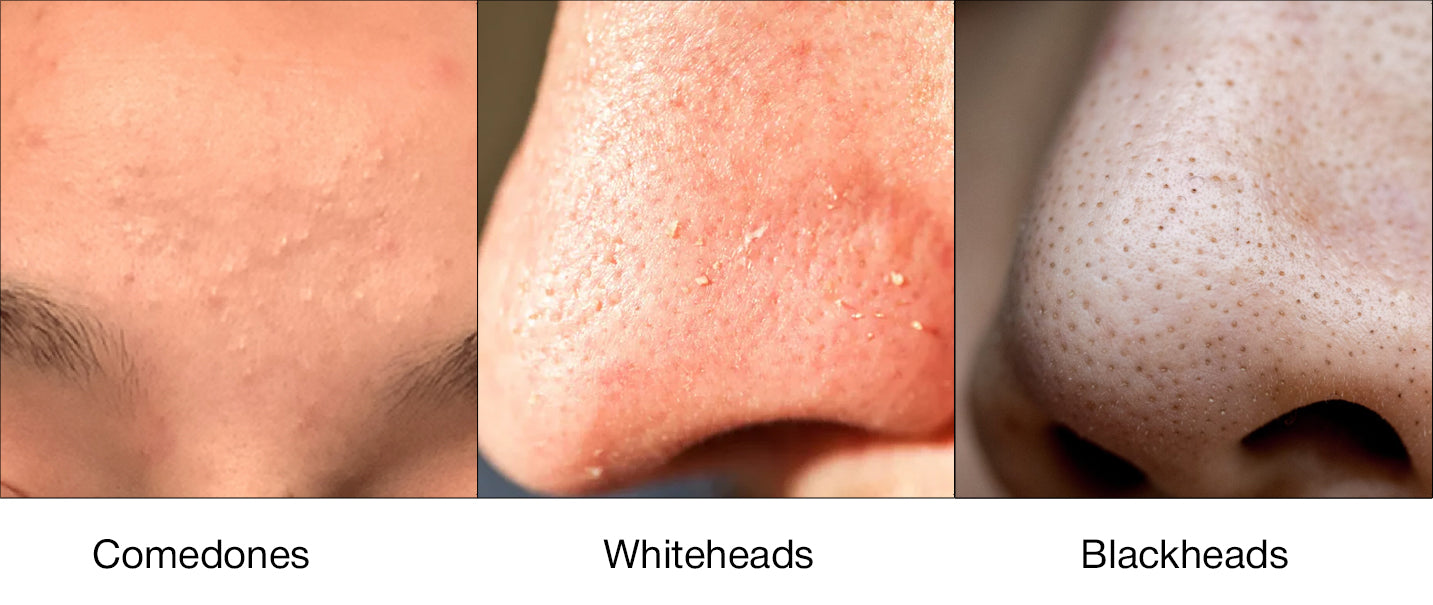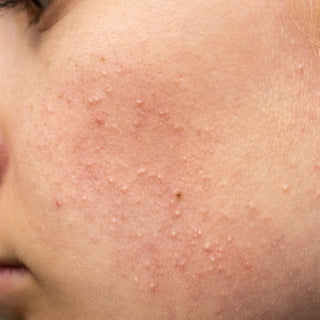If your skin feels rough, bumpy, or textured — but you're not seeing red, inflamed pimples — you might be dealing with closed comedones. These tiny, skin-colored bumps are a form of acne that’s easy to ignore, but tough to treat if you don’t know what’s causing them.
-
1. What Are Closed Comedones?
- 1.1 Comedones vs. Blackheads and Whiteheads
- 1.2 What Causes Comedones and Clogged Pores?
- 1.3 Best Ingredients for Comedones Treatment
- 1.4 The Ideal Skincare Routine for Closed Comedones
- 1.5 Pore-Clogging Products to Avoid
- 1.6 Can Lifestyle Changes Help Treat Comedones?
- 1.7 How Long Does Comedonal Acne Take to Treat?
- 1.8 Final Thoughts: Clearer, Smoother Skin Is Possible
Let’s break down what comedones really are, how they form, and most importantly, how to get rid of them for good using a comedones treatment that works.
What Are Closed Comedones?
Closed comedones are small, flesh-toned bumps that develop when clogged pores trap oil, bacteria, and dead skin cells beneath the skin’s surface. They’re commonly known as whiteheads, though they often don’t have a visible “head” like other pimples.
Closed comedones are a type of non-inflammatory acne, meaning they aren’t red or painful like cysts or pustules. But left untreated, they can become inflamed or turn into deeper breakouts.
They’re most commonly found on:
- Forehead
- Chin
- Jawline
- Cheeks
- Sometimes the chest and back
Comedones vs. Blackheads and Whiteheads
Comedones are simply clogged pores and blackheads and whiteheads are both just different types of comedones.

- Whiteheads (closed comedones): Pore is fully blocked beneath the surface. Skin looks bumpy but not red.
- Blackheads (open comedones): The top of the pore stays open and darkens due to oxidation — not dirt.
- Microcomedones: So small they may be invisible, but can develop into larger comedones.
What Causes Comedones and Clogged Pores?
Comedones form when dead skin cells and sebum (oil) get trapped inside hair follicles. But what causes that in the first place?
Common Triggers:
- Pore-clogging products (heavy creams, oils, silicone-based makeup)
- Over-moisturizing or layering too many products
- Skipping exfoliation or using the wrong type
- High humidity or sweating
- Smoking
- Hormonal fluctuations
- Diet high in dairy, sugar, or processed foods
The result? Congested skin, uneven texture, and stubborn clogged pores that won’t go away on their own.
Best Ingredients for Comedones Treatment
To clear closed comedones, you need ingredients that unclog pores, exfoliate gently, and regulate oil. Here are the most effective ones to look for:
Salicylic Acid for Comedones
- A beta hydroxy acid (BHA) that penetrates deep into pores
- Dissolves sebum and exfoliates from the inside out
- Especially effective for oily, acne-prone skin
Potassium Azeloyl Diglycinate (A type of Azelaic Acid)
- PAD is an azelaic acid derivative that is better absorbed by the skin and performs better than regular azelaic acid as a result, with minimal to no irritation
- PAD helps regulate sebum production, prevent new comedones and reduce inflammation
- It also helps to fade post acne marks (post-inflammatory erythema and post-inflammatory hyperpigmentation) faster
Niacinamide
- Balances oil production
- Strengthens the skin barrier
- Helps fade pigmentation
- Pairs well with exfoliants for gentle daily care
Retinoids
- Increase skin cell turnover
- Prevent buildup inside pores
The Ideal Skincare Routine for Closed Comedones
Here’s how to build a daily routine that targets clogged pores and keeps new comedones from forming:

Step 1: Gentle Cleanser (AM & PM)
Use a non-comedogenic cleanser that won’t strip your skin.
Here’s AccuFix Recommendations
Hydrating Gentle Daily Cleanser
Gentle Foaming Gel Face Wash
Step 2: Treatment product (2–3x per week)
Use a chemical exfoliant like:
- Salicylic Acid Gel Face wash for those who are new to using salicylic acid
- Salicylic Acid Serum for those who have been using it before or have more severe acne
- Glycolic acid (surface exfoliation) for those who have normal to dry skin,
Avoid harsh scrubs — physical exfoliation can make things worse.
Also consider incorporating ingredients like azelaic acid and niacinamide to more quickly reduce inflammation and help fade post acne marks fast.
Step 3: Moisturizer
Even oily or acne-prone skin needs hydration. Use a lightweight, non-comedogenic moisturizer, non-greasy moisturizer that won’t clog pores.
Step 5: Sunscreen
Sun damage slows healing and increases dark spots. Use a broad-spectrum SPF (minimum 30+) daily — especially if using acids or retinoids.
👉 Try: Invisible Shield with Centella SPF 50++++
The Ultimate Sunscreen SPF 50++++
Pore-Clogging Products to Avoid
Some ingredients are known culprits when it comes to clogged pores. Avoid these in makeup, moisturizers, and sunscreens:

🚫 Coconut oil
🚫 Fragrance (can irritate acne-prone skin)
🚫 Shea butter (can be too rich for some skin types)
A “non-comedogenic” label can help but everyone’s skin is different - and this includes what may or may not break someone out. Remember than comedogenic ratings are calculated using a 100% concentration of an ingredient on the back of a rabbit’s ear and might be far from representative of an ingredient actually functions in the end formula.
Can Lifestyle Changes Help Treat Comedones?
Absolutely! Skincare helps — but your lifestyle habits play a major role in prevention.
Tips That Make a Difference:
- Wash your face after sweating
- Change pillowcases twice a week
- Limit sugar, dairy, and fried foods
- Don’t sleep in makeup
- Avoid touching or squeezing bumps
- Add more whole, plant-based foods to reduce inflammation
How Long Does Comedonal Acne Take to Treat?
Consistency is everything. With the right routine:
- Mild comedones can clear in 4–6 weeks
- Stubborn cases may take 8–12 weeks or longer
- Prescription treatments may be needed if OTC products don’t help
Avoid jumping between products too quickly. Most treatments need time to work — give each new product at least 4 weeks before evaluating results.
Final Thoughts: Clearer, Smoother Skin Is Possible
Comedonal acne doesn’t have to be complicated. With the right combination of ingredients, exfoliation, and non-comedogenic skincare, you can take control of those stubborn bumps and achieve a clearer, smoother complexion.
🛒 Ready to clear your comedones the right way?
Start with gentle, proven ingredients like salicylic acid, azelaic acid, and niacinamide, and stay consistent with your skincare and lifestyle habits.
👉 Explore our Acne Starter Bundle for visible results

